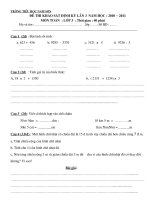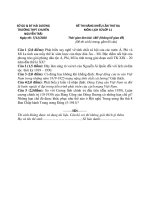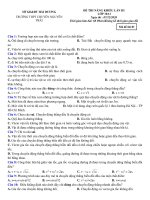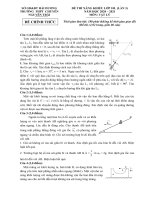đề thi năng khiếu lần 3 năm học 20202021
Bạn đang xem bản rút gọn của tài liệu. Xem và tải ngay bản đầy đủ của tài liệu tại đây (480.15 KB, 10 trang )
<span class='text_page_counter'>(1)</span><div class='page_container' data-page=1>
SỞ GD&ĐT HẢI DƯƠNG
<b>TRƯỜNG THPT CHUYÊN </b>
<b>NGUYỄN TRÃI </b>
ĐỀ
<b>KỲ THI NĂNG KHIẾU LẦN 3 </b>
<b>NĂM HỌC 2020 - 2021 </b>
<b>MÔN: TIẾNG ANH KHỐI 11 CHUYÊN </b>
<i><b>Thời gian làm bài: 180 phút (không kể thời gian giao đề) </b></i>
<i>(Đề thi có 10 trang) </i>
<b>Ngày thi: 07 tháng 12 năm 2020</b>
<b>PART I - LISTENING: (50 points) </b>
<b>You will hear each recording twice. </b>
<b>I. Listen to the recording and do the following tasks. (20 points) </b>
<i><b>Questions 1 – 3 </b></i>
<i>Answer the following questions using NO MORE THAN THREE WORDS AND/OR NUMBERS for each </i>
<i>answer. </i>
1. How long will the customer’s course last? ………
2. Which course has the customer already taken at the school? ………
3. How much discount can returning students qualify for? ………
<i><b>Questions 4 – 6 </b></i>
<i>Complete the following sentences using NO MORE THAN THREE WORDS AND/OR NUMBERS for each </i>
<i>gap. </i>
4. The customer’s address is ………
5. The customer can contact his former teacher by ……….
6. There are ………hours of classes each day, Monday to Friday.
<i><b>Questions 7 – 10 </b></i>
<i>Answer the following questions using NO MORE THAN THREE WORDS for each answer. </i>
7. What is the customer’s impression of the female Arabic teacher?
……….
8. What other languages can the customer speak?
……….
9. What does the customer decide is the third factor in choosing a school?
……….
10. What does the customer say the reception area should be like?
……….
<i><b>Your answers: </b></i>
<b>1. </b> <b>2. </b>
<b>3. </b> <b>4. </b>
<b>5. </b> <b>6. </b>
<b>7. </b> <b>8. </b>
<b>9. </b> <b>10. </b>
<b>II. For questions 11 – 15, you will hear the beginning of a radio interview with Stephen Perrins, a </b>
<b>composer of musicals. Listen and indicate the most appropriate response, A, B, C, or D. (10 points) </b>
11. The light songs Stephen wrote at college weren’t published because _______.
A. he couldn’t interest a publisher in them
B. he was afraid of people’s reactions
C. his family advised him against it
D. he didn’t think they would sell
</div>
<span class='text_page_counter'>(2)</span><div class='page_container' data-page=2>
B. it was commissioned for a school concert
C. they wanted to find out if they were able to do so
D. a music publisher asked them to write a musical
13. Stephen prefers not to write the lyrics for his shows because he _______.
A. would rather work with someone else
B. finds it difficult to write them
C. thinks they are of poor quality
D. is only interested in writing music
14. Stephen’s purpose in mentioning Helen Downes is to convince listeners that _______.
A. he has strong views about productions of his musicals
B. Helen Downes was an unsuitable director
C. the design for a particular show was of too low a standard
D. the director has ultimate responsibility for a production
15. Stephen claims that reason why some newspapers criticize him is that _______.
A. they think he is conceited
B. they don’t like his music
C. he isn’t interested in publicity
D. he tries to control his public image
<i><b>Your answers: </b></i>
11. 12. 13. 14. 15.
<b>III. Listen to the news and then fill in each blank with NO MORE THAN THREE WORDS. (20 </b>
<b>points) </b>
16. Because of a war counter to Israel, OPEC had to __________ opposed to the US and its allies.
17. The cost of petroleum __________ bringing about the lack of gas across America and Europe.
18. Many wars known as “oil wars” broke out against __________ as some countries wanted to control
that resource.
19. Bush administration was the leader of __________ of Iraq.
20. __________ as well as the former Secretary of Defense Chuck Hagel have since leaked out that oil
control played a dominating role in the decision to invade.
21. An investigation showed that countries with aggressive leaders and __________ are two-and-a-half
time likely to see military conflict.
22. Thanks to oil, producers made a good profit whilst __________ the rest of the world.
23. Despite OPEC’s effort, it is still opposed to the United States oil leading to further conflict and
__________.
24. It is hoped that this renewable energy finally takes this __________ off the bargaining table entirely.
25. While __________ are competing to have the most oil as we mentioned, the resource is slowly
dwindling.
<b>Your answers: </b>
<b>16. </b> <b>21. </b>
<b>17. </b> <b>22. </b>
<b>18. </b> <b>23. </b>
<b>19. </b> <b>24. </b>
</div>
<span class='text_page_counter'>(3)</span><div class='page_container' data-page=3>
SỞ GD&ĐT HẢI DƯƠNG
<b>TRƯỜNG THPT CHUYÊN </b>
<b>NGUYỄN TRÃI </b>
ĐỀ
<b>KỲ THI NĂNG KHIẾU LẦN 3 </b>
<b>NĂM HỌC 2020 - 2021 </b>
<b>MÔN: TIẾNG ANH KHỐI 11 CHUYÊN </b>
<i><b>Thời gian làm bài: 180 phút (không kể thời gian giao đề) </b></i>
<i>(Đề thi có 10 trang) </i>
<b>Ngày thi: 7 tháng 12 năm 2020</b>
<b>PART 2 – GRAMMAR – VOCABULARY – LANGUAGE FUNCTIONS (30 points) </b>
<i><b>I. Choose the best answer. (20 points) </b></i>
1. The government has made no ________ in the fight against inflation; indeed, the situation has
worsened recently.
A. headway B. effect C. avail D. triumph
2. The completion of the new Town Hall has been ________ owing to a strike.
A. held off B. held down C. held up D. held on
3. People under 21 years old are not ________ to join this club.
A. desirable B. eligible C. advisable D. admissible
4. News of the attempted coup began to ________ through to the outside world.
A. pour B. filter C. broadcast D. drip
5. My secretary was ________ to have typed those letters already.
A. asked B. supposed C. requested D. ordered
6. If I had invented the book, I would be ____as a genius.
A. accosted B. hailed C. exalted D. addressed
7. The film was a bit ____on plot but the special effects were great.
A. poor B. bad C. short D. small
8. Some authors use their novels as a ____to put over a message.
A. carriage B. method C. cover D. vehicle
9. Her eyes were tired from gazing at the ____screen of her computer all day.
A. flickering B. twinkling C. glimmering D. sparkling
10. They were able to ____over their meal and enjoy it instead of having to rush back to work.
A. loiter B. stay C. linger D. dwell
11. Don’t get yourself ___ up over such a trivial matter.
A. done B. worried C. whipped D. worked
12. My sunburnt nose made me feel rather ___ for the first few days of the holiday.
A. self-effacing B. self-centered C. self-conscious D. self-evident
13. There was a lot of ___ as throngs of people tried to see the famous actor walking through the mall.
A. stamina B. discipline C. counsel D. commotion
14. When the ship docked at Hamburg, they found a(n) ___ in the hold.
A. gate-crasher B. stowaway C. interloper D. trespasser
15. He wants to pay the bill himself, but I won’t hear ___ it.
A. from B. about C. of D. for
16. When his parents are away, his eldest brother ___.
A. knocks it off B. calls the shots C. draws the line D. is in the same boat
17. He’s a nice guy, always already to do somebody a good __________
A. present B. play C. turn D. pleasure
18. Family relationships later ___________ a much significance on his life
A. took on B. kept up C. take up D. take on
19. When John was arrested for drunken driving, he expected to lose his driving license, but he was
_________ with a fine.
</div>
<span class='text_page_counter'>(4)</span><div class='page_container' data-page=4>
A. intriguing B. inquisitive C. ingenious D. captivating
<i><b>II. Complete the sentences with the correct form of the words in brackets (10 points). </b></i>
<b>THE ROLE OF EDUCATION IN THE DEVELOPING WORLD </b>
Levels of illiteracy and (1. NUMBER) ________________ remain startlingly high in the developing
world, and continue to be so until the West provides or sponsors new education initiatives, preferably also
getting directly involved. A better education is a prerequisite should the (2. POVERTY)
________________ masses of Africa ever wish to hold any genuine hope of gaining their (3.
EMANCIPATE) ________________ from the metaphorical shackles of poverty. Education initiatives for
young people as well as life-long learning programmes will also help to breach the gulf that separates the
working classes from their ruling elite, a (4. PRIVILEGE) ________________ few who enjoy the
(5.TRAP) ________________ of Western wealth and the lifestyle that goes with it, while those in their
midst are completely preoccupied with the daily struggle for survival. Furthermore, we must promote a
culture of (6. TOLERATE) ________________ of corruption, and help to create a new generation for
whom education rather than a(n) (7. SCRUPLE) ________________ nature will reap the true rewards.
Education will also help to bridge another gap; that of the cultural one which separates the West from its
brethren in the developing world. The slums and shanty towns are a hotbed of religious and political (8.
EXTREME) ________________, but hopefully education will serve to create a better sense of
understanding between all the peoples of the world, (9. RESPECT) ________________ of background.
And this will especially be the case if the education programmes themselves are administered by Western
professionals, who, in much the same way as they can teach a thing or two to their counterparts in the
developing world, have also, no doubt, much to learn from them in the process as well. Cooperation
between people from different cultures of the West and the developing world will also, hopefully, help to
reduce levels of prejudice, bigotry, xenophobia and racial tensions. And, last but not by any means least,
educating women will (10. POWER) ________________ them to claim their rightful place in the social
hierarchy in up-to-now male-dominated cultures. Their aspirations can shift realistically higher, and
young female students can hope to go on to become tomorrow’s politicians, diplomats and political
leaders, or whatsoever they choose.
<b>PART 3 – READING (50 points) </b>
<i><b>I. Read the following passage and decide which option A, B, C or D best fits each sentence. (10 points) </b></i>
Nearly 200 of the 1500 native plant species in Hawaii are at risk of going extinct in the near future
because they have been (1)_______ to such low numbers. Approximately 90 percent of Hawaii's plants
are found nowhere else in the world but they are (2)_______ by alien invasive species such as feral goats,
pigs, rodents and (3)_______ plants.
The Hawaii Rare Plant Restoration Group is striving to (4)_______ the extinction of the 182 rare
Hawaiian plants with fewer than 50 individuals remaining in the (5)_______ . Since 1990, (6)_______ a
result of their "Plant Extinction Prevention Program", sixteen species have been brought into (7)_______
and three species have been reintroduced. Invasive weeds have been removed in key areas and fencing put
up in order to (8)_______ plants in the wild.
In the future the Hawaii Rare Plant Restoration Program aims (9)_______ collecting genetic material
from the remaining plants in the wild for storage as a safety net for the future. They also aim to
manage wild populations and where possible reintroduce species into (10)_______ .
1. A. developed B. reduced C. disappeared D. increased
<b>2. A. conserved </b> B. guarded C. invested D. threatened
3. A. native B. national C. international D. non-native
4. A. prevent B. influence C. encourage D. stimulate
5.A. wild B. sky C. hole D. atmosphere
6. A. so B. due C. as D. but
7. A. contamination B. production C. cultivation D. generation
8. A. derive B. vary C. remain D. protect
9. A. at B. on C. with D. for
</div>
<span class='text_page_counter'>(5)</span><div class='page_container' data-page=5>
<b>II. Read the following passage and choose the best answer. (10 points) </b>
</div>
<span class='text_page_counter'>(6)</span><div class='page_container' data-page=6>
A. discussing the relationship between the size of mammals and the nature of vegetation in their habitats
B. contrasting ecological conditions in India and Africa
C. proving the large animals do not require much food
D. describing the size of animals in various parts of the world
<b>2. According to the author, the ‘prejudice’ has led to __________ </b>
A. errors in the reasoning of biologists B. false ideas about animals in Africa
C. doubt in the mind of the author D. incorrect assumptions on the part of geologists
3. The author uses information provided by Dr. Smith to __________.
A. supply information on quality and quantity of plant life in South Africa
B. indicate the presence of large numbers of animals
C. give evidence of numbers of carnivorous animals
D. A, B and C are correct
4. The flocks of migratory birds are mentioned to __________.
A. describe an aspect of the fauna of South Africa B. indicate the abundance of wildlife
C. contrast with the habits of the antelope D. suggest the size of antelope herds
<b>5. The ‘carnage’ refers to the __________. </b>
A. number of animals killed by hunters B. number of prey animals killed by predators
C. number of people killed by lions D. amount of food eaten by all species
<b>6. To account for the ‘surprising’ number of animals in a ‘country producing so little food’, Darwin </b>
suggests all of the following as partial explanations except __________.
A. food requirements have been overestimated B. rapid regrowth of plant material
C. large area for animals to forage in D. mainly carnivorous animals
<b>7. The author makes his point by reference to all of the following except ___________. </b>
A. historical documents B. published illustrations
C. private communications D. recorded observations
8. Darwin quotes Burchell’s observations in order to ___________.
A. describe a region of great splendor B. counter a popular misconception
C. account for a curious situation D. illustrate a well-known phenomenon
9. Darwin apparently regards Dr. Smith as __________.
A. reliable and imaginative B. observant and excitable
C. intrepid and competent D. foolhardy and tiresome
10. Anterior probability refers to ___________.
A. what might have been expected B. ideas of earlier explorers
C. likelihood based on data from India D. hypotheses of other scientists
<i><b>III. The reading passage below has eight paragraphs, A-H. Reading the passage and do the tasks </b></i>
<i><b>below. (20 points) </b></i>
<b>The great survivor </b>
TV has coped well with technological change. Other media can learn from it
<b>A. NEWSPAPERS are dying; the music industry is still yelping about iTunes; book publishers think they </b>
are next. Yet one bit of old media seems to be doing rather well. In the final quarter of 2009 the average
American spent almost 37 hours a week watching television. Earlier this year 116m of them saw the
Super Bowl—a record for a single programme. Far from being cowed by new media, TV is colonising it.
Shows like “American Idol” and “Britain's Got Talent” draw huge audiences partly because people are
constantly messaging and tweeting about them, and discussing them on Facebook.
</div>
<span class='text_page_counter'>(7)</span><div class='page_container' data-page=7>
choose” a provider. This is not merely bluster. As our special report this week explains, once people start
paying for greater television choice, they rarely stop.
<b>C. It helps that TV is an inherently lazy form of entertainment. The much-repeated prediction that people </b>
will cancel their pay-TV subscriptions and piece together an evening's worth of entertainment from free
broadcasts and the internet “assumes that people are willing to work three times harder to get the same
thing”, observes Mike Fries of Liberty Global, a cable giant. Laziness also mitigates the threat from
piracy. Although many programmes are no more than three or four mouse clicks away, that still sounds
too much like work for most of us. And television-watching is a more sociable activity than it may
appear. People like to watch programmes when everybody else is watching them. Give them devices that
allow them to record and play back programmes easily, and they will still watch live TV at least
four-fifths of the time.
<b>D. Yet these natural advantages alone are not enough to ensure television's survival. The internet threatens </b>
TV just as much as it does other media businesses, and for similar reasons. It competes for advertising,
offering firms a more measurable and precise way of reaching consumers. Technology also threatens to
fracture television into individual programmes, just as it has ruinously broken music albums into
individual tracks. TV has endured because it has responded better to such threats than other media
businesses.
<b>E. One of the lessons from TV is to accept change and get ahead of it. Broadcasters' initial response to the </b>
appearance of programmes online was similar to the music industry's reaction to file-sharing: call in the
lawyers. But television firms soon banded together to develop alternatives to piracy. Websites like Hulu, a
joint venture of the American broadcasters ABC, Fox and NBC, have drawn eyeballs away from illicit
sources. Gradually it has become clear that these websites pose a threat to the TV business in themselves,
and that they are not bringing in as much advertising money as might be expected (which is similar to the
problem faced by the newspaper business). So television is changing tack again.
<b>F. With impressive speed, TV firms are now building online subscription-video services. The trendiest </b>
model is authentication: prove that you subscribe to pay-television and you can watch all the channels that
you have paid for on any device. Such “TV Everywhere” services are beginning to appear in America and
Canada. It is likely that Hulu will become a “freemium” service—mostly free, but with some shows
hidden behind a paywall. The move from an ad-supported model to a mixture of subscriptions and
advertising is tricky, but logical. It shows that it is not enough to embrace technological change.
Businesses must also work out how to build digital offerings that do not cause their analogue ones to
collapse.
<b>G. Television has domesticated other disruptive technologies. Ten years ago digital video recorders like </b>
TiVo promised to transform the way people watched TV. The devices made it easy to record programmes
and play them back, zooming through ads. The TV networks responded by running advertisements that
work at high speed. Cable and satellite companies built cheap digital video recorders into set-top boxes
and charged viewers extra for them. In effect, money flowed back to the television business. In Britain
those boxes will soon be deployed to deliver targeted advertising, enabling the living-room television to
compete with the internet.
<b>H. Other outfits are learning from TV. Record labels sound terribly innovative when they talk about </b>
bundling music together with broadband subscriptions. Yet this model comes from television. For the past
few years ESPN, a sports giant, has been showing games on its website. The cost is buried in monthly
broadband bills. Hulu-style joint ventures are all the rage in media, too. Magazine publishers have set up
Next Issue Media, which is trying to shape the evolution of digital devices to suit their needs. The Digital
Entertainment Content Ecosystem aims to do the same for films.
<b>I. That box might appear to be sitting in the corner of the living room, not doing much. In fact, it is </b>
constantly evolving. If there is one media business with a chance of completing the perilous journey to the
digital future looking as healthy as it did when it set off, it is television.
</div>
<span class='text_page_counter'>(8)</span><div class='page_container' data-page=8>
i. How people subscribe TV channel
ii. Changes in services offered by TV firms
iii. A good example for other businesses
iv. A kind of media that never failed
v. Comparison between TV and internet
vi. How TV business survived despite advertising declination
vii. The advantage of indolence
viii. Valuable experience gained from TV business
ix. Superiority over other media business in competition
x. Benefits from the adoption of threatening technology
xi. Successful operation of an old media business
1. Paragraph A
2. Paragraph B
<i><b>Example: Paragraph C </b></i> <i><b>- vii </b></i>
3. Paragraph D
4. Paragraph E
5. Paragraph F
6. Paragraph G
<b>Questions 7-10: Do the following statements agree with the claims of the writer in the reading </b>
<b>passage? </b>
Write
<b>TRUE </b> if the statement agrees with the claims of the writer
<b>FALSE </b> if the statement contradicts the claims of the writer
<b>NOT GIVEN if it is impossible to say what the writer thinks about this </b>
7. TV business is declining as other media such as newspaper, music industry and book publisher.
8. TV audiences will cancel pay-TV subscription to turn to the Internet program.
9. The reason for TV business to survive is that new technology does not pose as much threat as other
media businesses.
10. Websites like Hulu have not brought large profits to television business as expected.
<i><b>IV. You will read an article about various birds in Britain and choose from the birds (A-D). The birds </b></i>
<i><b>may be chosen more than once. (10 points) </b></i>
<b>Of which birds are the following stated? </b>
1. On a number of occasions, fears concerning it have been expressed.
2. Its population growth is a reflection of how tough it is
3. It is known for following a routine
4. Its situation was improved by an initiative that has been referred to as unique
5. There is statistical evidence to support the view that it is a very popular bird
6. It can easily identified by its outline
7. A common perception of its has proved inaccurate
8. Growth in its number has been much more gradual than desired
</div>
<span class='text_page_counter'>(9)</span><div class='page_container' data-page=9>
<b>WINGED WINNERS AND LOSERS </b>
Birds in Britain come under scrutiny in a massive new study, Birds Britannica. A record of the avian
community in the 21st century, it reveals a continually evolving pattern. Mark Cocker, the principal
author of the tome, selects some cases.
<b>A. Red Kite </b>
The red kite's recent rise from a mere handful to several thousands is among the great stories of modern
conservation. Testimony to its flagship status is a recent Royal Society for the Protection of Birds poll
which ranked it with the golden eagle and song thrush in the nation's list of favourite birds.
The dramatic spread has hinged on a reintroduction scheme at six sites in England and Scotland using
kites originally taken from Spain and Sweden. The English releases began in the Chilterns in 1989 and
when these had achieved a healthy population, subsequent introductions were made in Northamptonshire
and Yorkshire using mainly English birds. The Scottish releases in the 1980s and 1990s have resulted in
populations totalling more than 50 pairs. Altogether there are now about 3,000 kites in Britain.
The formation of a "Kite committee" by members of the British Ornithologists Club in 1903 was central
to the bird's recovery. It endured for 90 years and has been described as being "without parallel in the
annals of bird protection anywhere in the world".
<b>B. Dartford Warbler </b>
This highly-attractive bird is confined to just five Western European countries as well as the north African
littoral, and has the smallest world range of any of our breeding birds. It is also a highly sedentary bird
and a major cause of decline is its great susceptibility to the cold. The worst case occurred in the two
successive hard winters of 1961 and 1962 when the numbers fell from 450 pairs to just 10.
Memories of this calamitous decrease, coupled with the bird's own tiny size and seeming delicacy, have
cemented our sense of an overarching vulnerability. It is one of the best British examples where a species'
local rarity has been assumed to equal almost constitutional weakness. Typical of our pessimism was a
1960s prediction that its breeding range would be virtually restricted to the New Forest "in the foreseeable
future". There was a similar anxiety in the proposal to trap large numbers ahead of severe winter weather
so that they could be safely released the following spring.
All the caution is perfectly understandable as an expression of our protective instincts towards a
much-loved bird. Yet it sits oddly with the warbler's continuing rise and expansion to a population of 1,925 pairs
by the year 2000. It has undoubtedly been helped by mild winters as well as the intensive management
and protection of England's lowland heath. Yet the Dartford Warbler's recent history illustrates how easy
it is to underestimate the resilience of a small rare bird.
<b>C. White-tailed Eagle </b>
It is difficult to judge which is the more exciting conservation achievement - the reintroduction of this
magnificent bird or of red kites. By wingspan and weight, this the largest eagle in Europe and one of the
biggest of all birds in Britain. However, if the species itself is on a grand scale, the size of the
reintroduced population is tiny and the pace of increase agonizingly slow. Almost 30 years after the
species was first released, there are just 23 pairs holding territory, and from 17 occupied eyries in 2001,
no more than 11 young fledged.
The project involved a remarkable team effort by various UK environmental groups, as well as the
Norwegian conservationists who organized the capture of the donated birds. Between 1975 and 1985, they
released 82 eagles (39 males and 43 females) from a special holding area on the Inner Herbridean island
of Rhum. Eight were later recovered dead, but in 1983 came the first breeding attempt.
</div>
<span class='text_page_counter'>(10)</span><div class='page_container' data-page=10>
<b>D. Spotted Flycatcher </b>
Even the greatest fans of this lovely bird, with its mouse-grey upper parts and whitish breast and belly,
would have to admit that it is rather drab. They have no more than a thin, squeaky, small song. However,
spotted flys compensate with enormous character.
The birds are instantly recognizable because of their large-headed, top-heavy shape that is distinctive even
in silhouette, and by the habit of returning to the same perch after their agile, twisting, aerial sallies for
insects.
They are adept at catching large species such as day-flying moths, butterflies, bees and wasps, whose
stings they remove by thrashing the victim against the perch. Their specialized diet means that they are
among the latest spring migrants to return and are now in serious decline because of half a century of
pesticide use. In the past 25 years, their numbers have declined by almost 80 per cent, but they are still
sufficiently numerous (155,000 pairs) to be familiar and are often birds of large gardens, churchyards or
around farm buildings.
<b>PART 4 – WRITING: (40 points) </b>
<b>Write an essay of about 250 words to express your opinion on the following topic: </b>
</div>
<!--links-->









